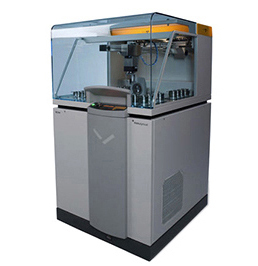X-ray fluorescence
Room: 1241
Contact person: Dr. Olivier Reubi (+41 21 692 43 22)
Head: Prof. Othmar Müntener
X-ray florescence spectrometry is a destructive method used to identify and quantify the chemical elements present in solid, powdered and liquid samples. XRF is capable of measuring elements from fluorine to uranium, and in concentrations > 1 ppm.
PANalytical AxiosmAX 
Wavelength dispersive X-ray fluorescence spectrometer fitted with a 4,0 KW Rh X-ray tube. It is set up to analyse a wide range of major and trace elements in geological and environmental materials.
Routine analyses of major elements (SiO2, TiO2, Al2O3, Fe2O3, MnO, MgO, CaO, Na2O, K2O, P2O5, Cr2O3, NiO) are performed on fused-disks prepared from 1.2 g of calcined sample powder mixed with Lithium-Tetraborat. Calibrations based on certified international standards are available for high-SiO2 and low-SiO2 rocks, carbonate rocks, phosphate rocks, as well as Mn- and Fe-rich materials.
Routine trace elements analyses (Sc, V, Cr, Mn, Co, Ni, Cu, Zn, Ga, Ge, As, Se, Br, Rb, Sr, Y, Zr, Nb, Mo, Ag, Cd, Sn, Sb, Te, I, Cs, Ba, La, Ce, Nd, Sm, Yb, Hf, Ta, W, Hg, Tl, Pb, Bi, Th, U) are conducted on disks obtained by pressing 12 g of sample powder on a support of Hoechst-wax-C. The limits of detection depend on the element concerned and the matrix but are typically in the range 1 to 7 ppm.
Schedule:![]() . Bookings: Olivier Reubi (+41 21 692 43 22)
. Bookings: Olivier Reubi (+41 21 692 43 22)
